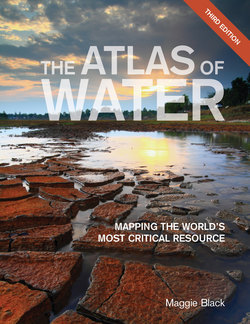Читать книгу The Atlas of Water - Maggie Black - Страница 10
На сайте Литреса книга снята с продажи.
ОглавлениеWater profligacy Food is one of the most thirsty water consumers. Over 70 percent of water withdrawals are used for agriculture, to irrigate fields or spray crops. But much of this water fails to reach its target – the roots of the plants; it is lost to the atmosphere, or returned to the water system unused. If poorly managed, channel irrigation can actually damage the soil, leaving it saline and unproductive. For this and many other reasons, including the social disruption and environmental damage caused by large dams, it is generally acknowledged that the train of “progress”, in which large-scale irrigation projects opened up new agricultural land for cultivation, has run into the buffers. Despite the uneven distribution of land ownership and cheap food, since the expansion of food production that accompanied the Green Revolution it has been possible to envisage a time when no child would go to bed hungry. But over 780 million people are still without a sufficient or nutritious diet, and making a serious dent in the hunger figures is becoming increasingly difficult. If food production is to keep pace with increasing population, and prices are to be kept in check, water efficiency in agriculture will have to be given far more attention. Volumes available for agriculture are likely to decline or remain static as industry and expanding urban centres increase their share. Technology will have to be harnessed to reducing water wastefulness. Up to now, hybrid seeds have mostly required extra water for cultivation; more attention will have to be focused on plant strains that require less water. Farmers will have to rediscover respect for environmental parameters, with drylands used for drought-resistant grains and tubers. Investment is needed in small-scale irrigation and water-harvesting techniques, which could improve the livelihoods of millions of farming families, especially in Africa but also in South Asia. Irrigation needs to be carefully managed, and combined with measures to improve the water-holding quality of the soil, nurture its fertility and increase yields from rain-fed crops. As pressures mount, food production will have to focus on items that use less water per unit of energy or nutrition than the red meat so highly prized in Western cultures. Reduction of water profligacy and improved efficiency are also needed for water use in manufacturing. In many Western countries, water conservation has been enforced by regulation and pricing to the point that recent expansion in industrial water use has been relatively constrained. The challenge is to ensure that these kinds of measures are taken up by less developed and industrializing countries, where water governance and regulatory frameworks are weaker and more frequently flouted. On the domestic front, appliances such as toilets and washing-machines that use less water are now widely available, but even these, as they are taken up by the new middle-class in countries such as China and India, will have a major impact on the quantity of fresh water used in towns and cities, and on the quantity of wastewater discarded. The amount of water used per household varies enormously around the world, and a large part of it is invisible. Consumption is not limited to drinking, bathing, flushing the toilet, using the dishwasher and watering the garden, adding up to well over 100 litres
11
